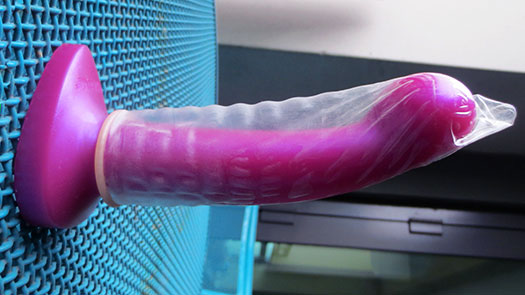Should you be wrapping up your dildos? Here’s some important info to know!

If you’ve ever spent time in the presence of a sex educator, you know that we love condoms. Condoms, condoms, condoms. And we think you should probably be using them.
However, there are some things about condoms that no one ever really tells you. For instance, did you know that chapstick (and other lip products) can eat through latex? That’s important info to have if you’re doing any sort of oral with latex condoms or dams, but I guarantee that the majority of people do not know this.
Similarly, a lot of people recommend using condoms with your sex toys. And that’s not necessarily bad advice, but there are some caveats to be aware of, so that’s what we’re gonna talk about today!
One of the main reasons I see people suggest using condoms with sex toys is if the toy in question is really porous.
Some toy materials like TPR/TPE, jelly, rubber, PVC, Cyberskin, etc. can easily harbor bacteria, viruses, and mold in their pores and can’t really be sanitized beyond the surface.
Something else to know about porous toys? They’re softened with oils. And because those materials aren’t very stable, over time they begin to break down and release these oils. This is why they often feel sticky or leave a greasy residue. And, of course, oils degrade latex.
My friend Lilly did an experiment on her blog awhile back where she covered jelly, TPR, and silicone dildos with latex condoms. The condoms warped and broke on the porous toys, but had no problems on an effectively non-porous silicone toy (because silicone is compatible with latex).
So if you’re going to use a condom on a porous sex toy, it should ideally be made of polyurethane or nitrile, which are compatible with oils. However, one of the main reasons people cite for buying porous toys is that they’re cheap, while polyurethane and nitrile condoms are often expensive.
Furthermore, a lot of toys (particularly dildos) have flared bases and/or balls that stick out. These are difficult to cover with a condom, but they still often come in contact with your nether regions and retain bacteria that can spread to the rest of the toy.
So the safest thing to do is avoid porous toys entirely and stick with non-porous materials like silicone and glass. Nowadays safe toys can be had for pretty cheap — I’ll link my Top Sex Toys Under $30 guides in the description — and your body will appreciate it. Especially because…
Porous toys are often toxic, and condoms may not protect you from toxic toys.
People often get a false sense of security when it comes to using condoms on toys containing phthalates, chlorine, and other toxicants. But not only are there no studies to know whether condoms offer any protection against these things, I have actually heard multiple accounts of people experiencing chemical burns and other symptoms from toxic toys even with condoms.
Once again, I urge you to stick with silicone for your soft sex toys. But another thing no one ever tells you about condoms is that…
Most condoms are lubricated with silicone lube.
Almost all condoms these days come pre-lubricated, and the majority of the time that lube is silicone-based. There are a few different reasons for this: Silicone lube is slicker and lasts longer than water-based. And water-based lubes can contain a wider range of ingredients that are either straight-up bad (like propylene glycol) or that certain individuals can be allergic to (like aloe).
I once read that back when water-based lubes on condoms was the norm, people would sometimes experience irritation after using condoms and assume it meant they had a latex allergy, when they were actually having a reaction to the lube on it. I don’t know if that’s true, but it would make sense.
Now, one of the problems with silicone lube is that it can sometimes degrade silicone sex toys, depending on a variety of factors including types and qualities of silicone. And for some reason, condom manufacturers pretty much never list the lube ingredients on the package, which is really annoying.
If you want to use silicone toys with condoms and don’t want to run the risk of losing them to some mystery lube, I recommend pairing non-lubricated condoms with the water-based lube of your choice.
So those are the things you need to know if you’re going to be pairing condoms with your sex toys! If you’ve got any other questions, leave them down below.
Thanks for watching, and I’ll see you next time!




